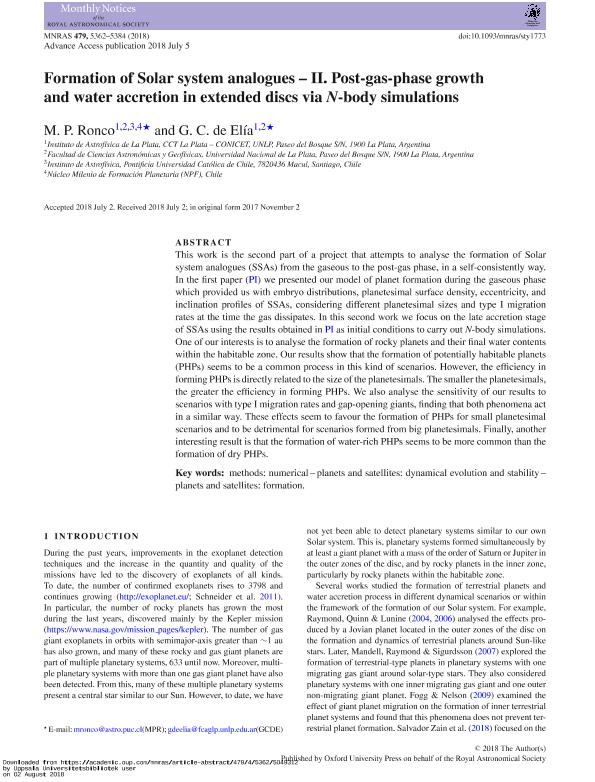Mostrar el registro sencillo del ítem
dc.contributor.author
Ronco, María Paula

dc.contributor.author
de Elia, Gonzalo Carlos

dc.date.available
2021-10-28T18:39:52Z
dc.date.issued
2018-10
dc.identifier.citation
Ronco, María Paula; de Elia, Gonzalo Carlos; Formation of Solar system analogues – II: Post-gas-phase growthand water accretion in extended discs via N-body simulations; Oxford University Press; Monthly Notices of the Royal Astronomical Society; 479; 4; 10-2018; 5362-5384
dc.identifier.issn
0035-8711
dc.identifier.uri
http://hdl.handle.net/11336/145396
dc.description.abstract
This work is the second part of a project that attempts to analyse the formation of Solar system analogues (SSAs) from the gaseous to the post-gas phase, in a self-consistently way. In the first paper (PI) we presented our model of planet formation during the gaseous phase which provided us with embryo distributions, planetesimal surface density, eccentricity, and inclination profiles of SSAs, considering different planetesimal sizes and type I migration rates at the time the gas dissipates. In this second work we focus on the late accretion stage of SSAs using the results obtained in PI as initial conditions to carry out N-body simulations. One of our interests is to analyse the formation of rocky planets and their final water contents within the habitable zone. Our results show that the formation of potentially habitable planets (PHPs) seems to be a common process in this kind of scenarios. However, the efficiency in forming PHPs is directly related to the size of the planetesimals. The smaller the planetesimals, the greater the efficiency in forming PHPs. We also analyse the sensitivity of our results to scenarios with type I migration rates and gap-opening giants, finding that both phenomena act in a similar way. These effects seem to favour the formation of PHPs for small planetesimal scenarios and to be detrimental for scenarios formed from big planetesimals. Finally, another interesting result is that the formation of water-rich PHPs seems to be more common than the formation of dry PHPs.
dc.format
application/pdf
dc.language.iso
eng
dc.publisher
Oxford University Press

dc.rights
info:eu-repo/semantics/openAccess
dc.rights.uri
https://creativecommons.org/licenses/by-nc-sa/2.5/ar/
dc.subject
PLANETS AND SATELLITES: DYNAMICAL EVOLUTION AND STABILITY
dc.subject
PLANETS AND SATELLITES: FORMATION
dc.subject
METHODS: NUMERICAL
dc.subject.classification
Astronomía

dc.subject.classification
Ciencias Físicas

dc.subject.classification
CIENCIAS NATURALES Y EXACTAS

dc.title
Formation of Solar system analogues – II: Post-gas-phase growthand water accretion in extended discs via N-body simulations
dc.type
info:eu-repo/semantics/article
dc.type
info:ar-repo/semantics/artículo
dc.type
info:eu-repo/semantics/publishedVersion
dc.date.updated
2021-08-23T15:19:45Z
dc.identifier.eissn
1365-2966
dc.journal.volume
479
dc.journal.number
4
dc.journal.pagination
5362-5384
dc.journal.pais
Reino Unido

dc.journal.ciudad
Oxford
dc.description.fil
Fil: Ronco, María Paula. Consejo Nacional de Investigaciones Científicas y Técnicas. Centro Científico Tecnológico Conicet - La Plata. Instituto de Astrofísica La Plata. Universidad Nacional de La Plata. Facultad de Ciencias Astronómicas y Geofísicas. Instituto de Astrofísica La Plata; Argentina. Pontificia Universidad Católica de Chile; Chile
dc.description.fil
Fil: de Elia, Gonzalo Carlos. Consejo Nacional de Investigaciones Científicas y Técnicas. Centro Científico Tecnológico Conicet - La Plata. Instituto de Astrofísica La Plata. Universidad Nacional de La Plata. Facultad de Ciencias Astronómicas y Geofísicas. Instituto de Astrofísica La Plata; Argentina
dc.journal.title
Monthly Notices of the Royal Astronomical Society

dc.relation.alternativeid
info:eu-repo/semantics/altIdentifier/doi/http://dx.doi.org/10.1093/mnras/sty1773
dc.relation.alternativeid
info:eu-repo/semantics/altIdentifier/url/https://academic.oup.com/mnras/article/479/4/5362/5049312
Archivos asociados
